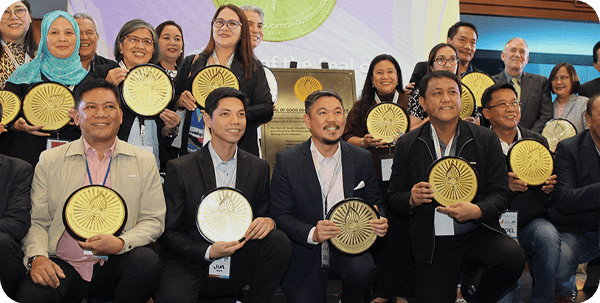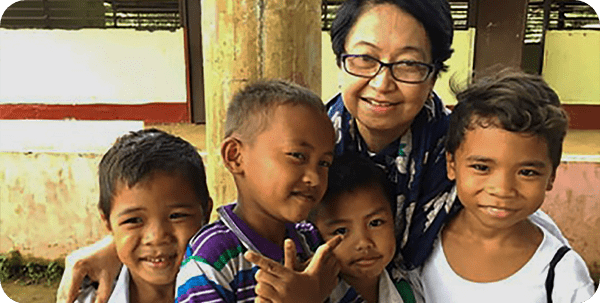KASpaces: Rethinking Educational Infrastructure and Teacher Development
April 28, 2022
Oftentimes in educational conferences in the Philippines and abroad, I am drawn to discussions on inventive ways to get students to learn; how to make them think creatively, how to develop inquiry in their minds, and develop opinions, critiques, and a highly developed appreciation of the things around them, instead of just pushing the “Like” button.
For over half a century, I have taught and lectured teachers and students and, more recently, under the auspices of our educational organization, Synergeia. Every time I am in front of an audience, I test reactions to what I say or project onscreen. I look for what engages an audience, what makes them linger in my phrases, what makes an impact in the way I juxtapose sentences or pause for effect.
Teaching creativity in the advanced world oftentimes means having each student or teacher in front of a computer screen learning the most creative app with often colorful and cheerful greetings. Oftentimes, the presentation is fast-clipped, reflective of the fast pacing of their society. It is assumed that each participant has a level of technical savvy to be at a screen not aided and can fix any glitch when it happens. Any teacher will be enthused to add to one’s teaching arsenal how to get students to be engaged.
But I come from the Philippines and poverty rears its obstructive head at any attempt to improve creative learning. For example, in a recent Zoom class that I had with a class on improving English grammar about 100 kilometers north of Manila, where I am, the class has selected students who showed high interest in the selected subjects and had access or ownership to a cell phone, which would be their video screens for the next hour. That lessened the class to half, or a total of 20 students. The attendance number would later decline throughout the hour. There were brownouts, or electric stoppage, which cancelled the participation of four or five students Then there was the matter of weak signals. Students connected intermittently and when they decided to find a steady signal, they resorted to climb a tree or run up the side of a mountain to secure a signal. When, finally, the remainder of the students made it so far, connected, there were issues of self-confidence and inability to speak with confidence. They needed goading and eventually responded and interacted. But that was only with 15 minutes left. Clearly, any sort of modern act of inclusion in creative teaching will hardly work in the Philippine setting. Let me therefore share with you what I do in an underdeveloped country without the accoutrements of creating the impossible.
First, I welcome the return of face-to-face teaching. I welcome that because of the very faulty Zoom teaching and the failed modules that were distributed throughout the country, in lieu of a teacher’s absence.
Next, I welcome the return of teachers renewing basic reading lessons The pandemic has significantly decreased the reading and comprehension skills of students. If the national scores before the pandemic showed students behind, it has been exacerbated by the pandemic and the accompanying school disruption. With the return of face-to-face classes, we are back with the opportunity to increase reading and comprehension and, in like manner, lay the groundwork for creative thinking. I will share with you some low-tech but effective teaching methods that I’ve used to spawn creative thinking and inquiry. These methods include using visuals employing storytelling establish a reading mandate, accessibility to libraries, proving art materials, and visiting museums. I
In the area of visuals in a few weeks I will have an exhibition of my organization’s library, the Ortigas Library, an exhibition of 100 vintage photographs of the tribal people of the Mountain Province in the North. It will be in a high school in a small town known for having graduated high achieving students. The principal welcomed the exhibition, stating that test scores of her students have plummeted again due to the pandemic, and she needed another way to reach the students who have been without a schooling discipline and schedule. She believes the never-seen photographs of the students’ ancestors in their native dress, events, and local architecture that they no longer see will be a revelation to their identity and ignite a learning moment.
Storytelling. Teachers have been taught to develop an authoritarian reserve in their teaching. That, to me, is a prescription to failure. I have been successful communicating to students when I relate a personal story or insight. Personal storytelling decreases the unequal relationship between students and teachers, an informal manner of relating events and people, especially if they mirror the experiences of the students, are the wedges to securing access to the student’s mind.
A reading mandate. To be creative and to have an opinion means to have read much to reach such a level. Reading and the corresponding comprehension scores in the country are abysmal. If in the past, the level of television watching exceeded study and school time hours, now there is additional video gaming and mindless watching that wipes out the hours for potential reading.
I have been quite strict on a reading mandate. Whenever I go around the provinces, I just impose. I just tell the teachers there shall be no video and TV watching for the whole school week and watching is only allowed on weekends after homework is completed and for a few hours. My Draconian law is hard to implement, given the supervision parents and teachers have to do. But what has to be impressed is there must be reading time for at least a half hour each day. A book to read and later to report are also compulsory. Reading regains the flow of time in imbibing words in sentence and paragraph constructions, and, most importantly, in understanding the import of the author’s overall message. Reading has no abrupt ending like TikTok, as it leads a reader through stories that may have taken several days to finish reading. A student’s mind is rewired from the immediacy offered by video to a steady, more realistic pace of digesting the written text and making sense of it. Likewise, with TV’s dulling powers, reading has an engaging quality, raising questions and even greater thought and rumination on the matter.
Access to libraries. Libraries are under-utilized in my country. There are city and school libraries that are mostly free to enter and use. There are a fair number of libraries throughout the country and, unfortunately, much of the reading fare in them are dated. Nonetheless, there are good reading books still and there are current newspapers and magazines to read. Students must be acquainted with libraries as a place for reading and as a place for solace. In recent times, libraries, like the Ortigas Library, which I work in, have been visited to borrow books and documents that straighten and clarify the flurry of false news now besetting us.
Access to museums. The treasures in museums are undoubtedly a way to stimulate creative and critical thinking. Not all student visitors get that experience. The ways of a child’s socialization at home or at school affect the way stimuli is received as in a visit to a museum. A visit, nonetheless, is a departure from a normal day, allowing students to gaze at master artworks or ancient artifacts, spurring thought to wander and reflect. The mind is most supple to receiving wider dimensions of creative and critical thinking in a museum setting.
Lastly, access to art supplies. Art therapy has been used successfully in drawing and drawing out emotional expressions in children affected by external factors, such as war. So it is to devote time in school or at home sharing coloring pencils, paint brushes, and paper. This is a new world of communication for the student other than the written text. It stimulates students and, for some, it may lead a path to an artistic streak or vocation in the future.
For underdeveloped countries like the Philippines with a failed educational system, these low-tech methods of developing creative and critical thinking still manage to stimulate students in that direction
Lastly, the steep learning decline in students…. distributing modules in lieu of teachers’ absence, the faulty learning through cell phones and screens affected by no signals or weak signals have been a severe setback for education in the Philippines. We are ever more aware now that face-to-face teaching led by a well-trained dedicated corps of teachers and, mind you, parents, are the only and most effective way to spark the genius inherent in each student.
John Silva
Executive Director, Ortigas Foundation




